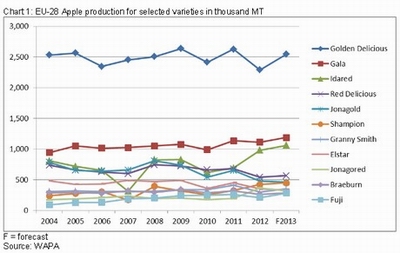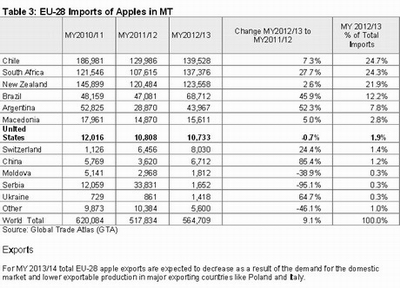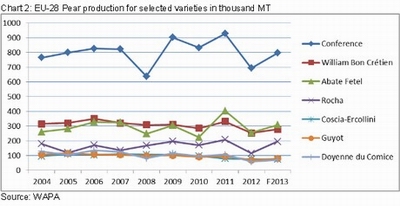Commercial apple production in MY 2013/14 is estimated at 10.2 MMT. This estimate is a 2.6 percent increase (260.8 MT) in production compared to the low output of MY 2012/13. Significantly higher apple production is expected to occur in France, Italy, Spain, Romania, the United Kingdom and Portugal and to some extent in The Netherlands, Bulgaria and the Czech Republic. Poland (23 percent of total production in MY 2013/14), Italy (21 percent), France (17 Percent), Germany (8 percent), and Spain (6 percent) are the top five producing member states and together account for 75 percent of the total EU commercial apple production.
This increase is partially offset by lower production in Germany, Hungary, Poland, Greece, Belgium and Austria. The decline in the apple crop in some of the above mentioned countries results from adverse weather conditions during spring. In
Hungary for example, the prolonged winter brought major losses in the honey bee population which, in combination with a short flowering period, led to poor pollination. Germany and Belgium also report lower crops due to cold spring conditions which caused problems during the fruit setting period. Earlier estimates for Austria have been revised down significantly because of high temperatures and drought during July and August, resulting in smaller fruit size and early fruit fall.

EU imports of U.S. apples decreased by 10 percent in MY 2011/12 mainly due to the enforcement of EU food additive legislation. For example, morpholine, a carrier for glazing agents applied to fruit, is approved for use in third countries such as Italy and Spain remain the major pear producing countries contributing to about half of total EU-28 production. Despite declining area, Italy’s pear production is expected to be 14 percent higher compared to MY2012/13. Of the 5 largest pear producing countries within the EU, area harvested continues to go up in Belgium while Italy, Spain and The Netherlands show a downward trend.Chile, the United States and Canada, but not in the EU. The U.S. apple industry has taken steps to ensure that fruit destined for the EU does not have any trace of morpholine. In MY 2012/13 EU apple imports from the U.S. remained fairly stable.










